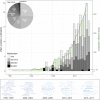A roadmap for urban evolutionary ecology
- PMID: 30828362
- PMCID: PMC6383741
- DOI: 10.1111/eva.12734
A roadmap for urban evolutionary ecology
Abstract
Urban ecosystems are rapidly expanding throughout the world, but how urban growth affects the evolutionary ecology of species living in urban areas remains largely unknown. Urban ecology has advanced our understanding of how the development of cities and towns change environmental conditions and alter ecological processes and patterns. However, despite decades of research in urban ecology, the extent to which urbanization influences evolutionary and eco-evolutionary change has received little attention. The nascent field of urban evolutionary ecology seeks to understand how urbanization affects the evolution of populations, and how those evolutionary changes in turn influence the ecological dynamics of populations, communities, and ecosystems. Following a brief history of this emerging field, this Perspective article provides a research agenda and roadmap for future research aimed at advancing our understanding of the interplay between ecology and evolution of urban-dwelling organisms. We identify six key questions that, if addressed, would significantly increase our understanding of how urbanization influences evolutionary processes. These questions consider how urbanization affects nonadaptive evolution, natural selection, and convergent evolution, in addition to the role of urban environmental heterogeneity on species evolution, and the roles of phenotypic plasticity versus adaptation on species' abundance in cities. Our final question examines the impact of urbanization on evolutionary diversification. For each of these six questions, we suggest avenues for future research that will help advance the field of urban evolutionary ecology. Lastly, we highlight the importance of integrating urban evolutionary ecology into urban planning, conservation practice, pest management, and public engagement.
Keywords: citizen science; community engagement; eco‐evolutionary feedback; gene flow; landscape genetics; urban evolution; urban socioecology.
Figures




References
-
- Alberti, M. , Correa, C. , Marzluff, J. M. , Hendry, A. P. , Palkovacs, E. P. , Gotanda, K. M. , … Zhou, Y. (2017). Global urban signatures of phenotypic change in animal and plant populations. Proceedings of the National Academy of Sciences of the United States of America, 114, 8951–8956. 10.1073/pnas.1606034114 - DOI - PMC - PubMed
LinkOut - more resources
Full Text Sources

